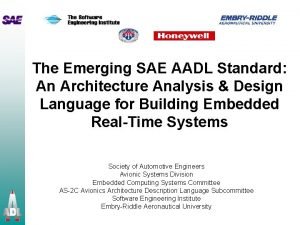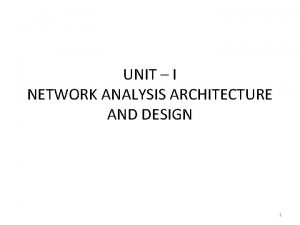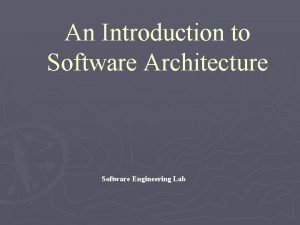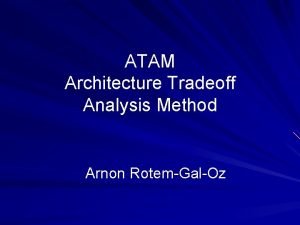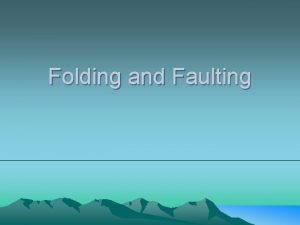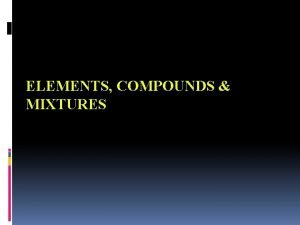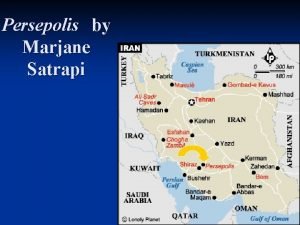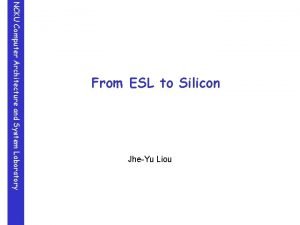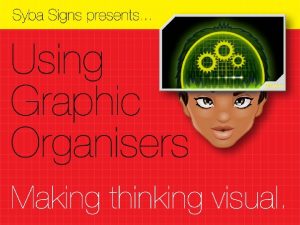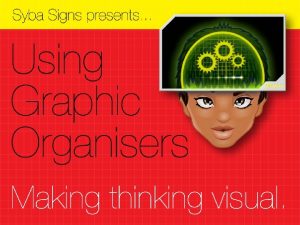Graphic Architecture introduction and analysis Liou JheYu Outline






























































- Slides: 62

Graphic Architecture introduction and analysis 劉哲宇, Liou Jhe-Yu

Outline • GPU Architecture history • Taxonomies for Parallel Rendering – Tile-based rendering • • Fixed function pipeline Separated shader architecture Unified shader architecture Conclusion

Architecture history Silicon Graphics, Inc. • • 1981 -2009 3 D graphics accelerator in early age. Focus on high-performance graphics server. Release its own IRSI-GL API in 1992, – The first open and industrial standard – IRIS-GL -> Open. GL

Architecture history From ashes • 1 st generation – wireframe – transform, clip, and project – color interpolation • Model – SGI Iris 2000, 1984

Architecture history From ashes • 2 nd generation – shaded solid – Lighting calculation – Depth buffer, alpha blending. • Model – SGI GTX, 1988

Architecture history From ashes • 3 rd generation – Texture mapping • Model – SGI Reality. Engine, 1992

Architecture history in the later time(after 2000) • Fixed function pipeline (- 2000) – With or without T&L engine • Vertex and Pixel shader (2001 - 2006) 3 DMark 2000 – 4 th generation • Unified shader (2007 - ) – 5 th 3 DMark 03 generation 3 DMark 11

Architecture history Fixed pipeline production • Desktop – NVIDIA Ge. Force 2 - NV 15 (2000) – ATI Radeon 7000 - R 100 (2000) – 3 dfx Voodoo 3 (1999) • Acquired by NVIDIA in 2002 – S 3 savage 2000 (1999) • Acquired by VIA in 2001 – Imagination STG Kyro - Power. VR 3 (2001) NV Ge. Force 2 • Mobile – Imagination MBX - Power. VR 3(2001) – ATI Imageon 130 (2002) • Sell to Qualcomm in 2009 and rename Imageon as Adreno which be integrated in their Snapdragon So. C. – Falnax Mali 55 (2005) • Acquired by ARM in 2006

Architecture history Vertex shader & Fragment shader • Desktop – NVidia Ge. Force 7900 - G 71 (2006) – ATI X 1900 – R 520 (2006) • Mobile – NVidia Ge. Force ULP (2011) • In NVidia’s Tegra 3. – Imagination SGX 545 (2010) – ARM Mali 400 (2009) – Qualcomm Adreno 220 (2010) NV Ge. Force 7900

Architecture history Unified shader • Desktop – NVidia Ge. Force 680 – GK 104 (2012) – AMD HD 7970 (2012) • Mobile – Imagination G 6400 (2012) – ARM Mali T 678 (2012) – Qualcomm Adreno 320 (2012) NV Ge. Force 680

Outline • GPU Architecture history • Taxonomies for Parallel Rendering – Tile-based rendering • • Fixed function pipeline Separated shader architecture Unified shader architecture Conclusion

Taxonomies for Parallel Rendering • Ideal parallel rendering

Taxonomies for Parallel Rendering • Sort-first – Work in multi GPU (NVIDIA’s SLI, AMD crossfire). • Sort-middle – Tiled-based rendering – Intel Larrabee, and most mobile GPU. • Sort-last – Immediate mode rendering – Most Desktop GPUs belong to this area.

Sort-first On SLI application

Sort-first • Advantage – Graphic Pipeline will receive no interrupt. – Easy to re-distribute job on existed hardware. • Disadvantage – Pre-transform are required • Harm the system performance obviously. – Enormous bandwidth requirement on frame buffer access

Sort-middle – Tiled-based rendering • Sorting triangles into tiles after geometry stage. • Raster engine wait until all triangles have been sorted. • Raster engine process tile by tile sequentially.

Tiled-based rendering

Tiled-based rendering Case study – ARM MALI 400

Tile-based Memory access model Geometry Primitive data Tile divider Tile list Raster Texture data On-chip tile buffer Frame buffer Memory

Tiled-based rendering • Advantage – Natural way to re-distribute jobs. – Save a lot of bandwidth for communication with frame buffer. • Disadvantage – One triangle may go into multiple tiles. – Need a sorting buffer after triangle sorting • More complex scene, more memory access. – Completely divide graphic pipeline into two partition. • This may harm the performance.

Sort-last • Delay sorting until decomposing primitive into fragment. Pixel vertex Raster vertex Pixel Raster Pixel

Sort-last • Graphic API has the strict limit on order rendering – EX. The pre-sort operation for Alpha blending race condition. Pixel vertex Raster Pixel Some resorting FIFO for order maintain Pixel blend

Sort last • Advantage – Full rendering pipeline without interrupt until perfragment operation (compare to sort-middle) • Disadvantage – Huge bandwidth requirement on frame buffer access, particularly in high resolution and antialiasing enable.

Memory access model Tile-based rendering Geometry Primitive data Geometry Tile divider Tile list Raster On-chip tile buffer Texture data Frame buffer Raster Frame buffer cache Immediate more rendering

Why does mobile GPU like sort-middle • Minimize bandwidth requirement. – Need system memory support. – High memory bandwidth usage will hammer the whole system. • Save more penguins (power). – Reducing memory access means less power consumption.

Why does desktop GPU use sort-last • Minimize performance issue – Sorting cost is low • Desktop GPU has its own dedicated memory. – Graphics DRAM usually has high bandwidth with high latency.

Outline • GPU Architecture history • Taxonomies for Parallel Rendering – Tile-based rendering • • Fixed function pipeline Separated shader architecture Unified shader architecture Conclusion: GPU architecture issue

Fixed function pipeline • NVIDIA Ge. Force 256 (1999) – First transformation and lighting(T&L) hardware • Become the market leader due to this production. – NVIDIA mark it as the world’s first GPU. – 1 vertex pipeline, 4 pixel pipeline

Memory access latency? • GPUs seldom care the memory latency because – Usually hundreds of fragments fly in the raster pipeline(queue). – Switch to the next fragment with tiny cost if texture cache/frame cache miss. • No pipeline stall is needed.

Separated shader architecture • NVIDIA Geforce 3 (2001) – First vertex shader and pixel shader architecture on desktop GPU. – 1 vertex shader, 4 pixel shader – Using Assembly code to program shader by microsoft shader model 1. 0 – Kill other competitors except ATI. • 3 dfx, S 3, sis, Maxtor, Power. VR

Separated shader architecture Case Study: Ge. Force 6 series • • NVIDIA Ge. Force 6800 (2004) 6 vertex shader 16 pixel shader, 16 fragment operation pipeline

Separated shader architecture Case Study: Ge. Force 6 series Input shaded fragment data Pixel X-bar Interconnect Multisample AA Z comp C comp Z ROP C ROP Frame buffer Partition Memory

Early Z-test

Early Z-Test concept • Put depth test before texture mapping to avoid unnecessary texel fetching. • Reduce the memory traffic (reduce texture cache miss)

Outline • GPU Architecture history • Taxonomies for Parallel Rendering – Tile-based rendering • • Fixed function pipeline Separated shader architecture Unified shader architecture Conclusion

Unified shader Architecture • Separated shader architecture limits the graphic application. – The input data rate is obviously slow than vertex shader process speed. • CPU’s processing speed is slow than GPU. – Force programmer to use more texture operations and less polygon/simple T&L operation.

Unified shader Architecture

Unified shader Architecture • ATI Xenos on Xbox 360 (2005) – The world first unified shader architecture. • 48 unified shaders

Unified shader Architecture Case study: NVIDIA Ge. Force 8800 • NVIDIA Ge. Force 8800 (2006) • 128 CUDA core in 8 stream processors (shader cluster) • 24 fragment pipeline(for z-test and color blend)

Unified shader Architecture NVIDIA Ge. Force 8800


Unified shader Architecture Case study: AMD ATI HD 2900 • AMD ATI HD 2900 XT (2006) • 64 unified shader (320 stream processor) – VLIW architecture, 5 operation one cycle. • 4 Render Back-End (For Z-test and color blend)

Unified shader Architecture AMD ATI HD 2900 XT

AMD ATI HD 2900 XT Placement & Layout • Fixed hardware : shader = 4 : 6 (maybe) – Not 0 : 1

A unified shader comparison in 2010 NVIDIA Ge. Force GTX 480 ATI Radeon HD 5870 • 480 cores (128 in 8800) • 177. 4 GB/s memory bandwidth • 1. 34 TFLOPS single precision • 3 billion transistors • 1600 cores (320 in 2900) • 153. 6 GB/s memory bandwidth • 2. 72 TFLOPS single precision • 2. 15 billion transistors Over double the FLOPS for less transistors! What is going on here?

Compared stream processor usage AMD vs NVDIA(Fermi vs rv 770)

Unified shader Architecture AMD 7970 (2012) • VLIW architecture is good for existed application, but bad for the unknown/future application. – VLIW’s compiler ability is limited. • From VLIW to SIMD

Unified shader Architecture Case study: Intel Larrabee • 32 x simplified Pentium CPU. – No out-of-order execution. – Compatible with X 86 -based program. • Sort-middle architecture

Unified shader Architecture Intel Larrabee • Announce in 2008, shutdown in 2010…… – Due to the performance issue. – The research result become part of Intel MIC ?

Outline • GPU Architecture history • Taxonomies for Parallel Rendering – Tile-based rendering • • Fixed function pipeline Separated shader architecture Unified shader architecture Conclusion

GPU architecture issue • Where should sort happen? – What is the purpose for Job re-distribution? • Hide memory latency, get more memory bandwidth. • Cull the hidden element as early as possible – Object, triangle, pixel • Programmable vs fixed ? – Reality vs ideal.

Trend GPU Parallel CPU programmable

Programmable vs fixed ? • Because of the Performance issue, tessellation become fixed hardware – Ge. Force 580 -> 680 – Direct. X 10 -> 11

Future lead way • Application lead hardware – Ray-tracing • Hardware limit application – For the money issue, more and more 3 D game companies prefer to stay in Xbox 360/PS 3. • Since 2007, the increasing rate of Image quality in 3 D game has been slow down.

Any Question?

You can get slides in 140. 116. 164. 239/~caslab/GPU_Present_NSYSU/


Example: use transparency texture to model a tree with some leaves • Step 1, draw the trunk 58

Example: use transparency texture to model a tree with some leaves • Step 2, draw leaves(use lots of triangles) Too slow ( n ) 59

Example: use transparency texture to model a tree with some leaves • Step 2, draw leaves(use transparency texture) Alpha = 0 Be dropped alpha test 60

Early depth test • Because of early depth test, the fragments which shall be dropped by alpha test update the depth buffer now. • So we separate Z-write and Z-test , and put Z-write behind the alpha test. 61

Early depth test • But separating z-test and z-write will cause data hazard problem. • Using multi-Z test to perform depth test twice and avoid data hazard. 10 5 15 10 5 62
 Vokal nasal mandarin
Vokal nasal mandarin Mit institutional research
Mit institutional research Ghost graphic story graphic and wayfinding
Ghost graphic story graphic and wayfinding Graphic weight meaning
Graphic weight meaning Sandwich quotes examples
Sandwich quotes examples Call and return architecture
Call and return architecture Overhead applied formula
Overhead applied formula Conclusion paragraph outline
Conclusion paragraph outline 5 paragraph essay
5 paragraph essay Introduction to software engineering course outline
Introduction to software engineering course outline Introduction to computer organization and architecture
Introduction to computer organization and architecture What is architecture business cycle?
What is architecture business cycle? Fundamental and incidental interactions
Fundamental and incidental interactions Slot modular architecture
Slot modular architecture Bus architecture in computer organization
Bus architecture in computer organization Cultural domain
Cultural domain Ad analysis outline
Ad analysis outline Competitive analysis outline
Competitive analysis outline Competitive analysis outline
Competitive analysis outline How to write a poetry analysis essay
How to write a poetry analysis essay Competitive analysis doc
Competitive analysis doc Aadl tutorial
Aadl tutorial Network analysis architecture and design
Network analysis architecture and design A graphic language and has its own alphabet and grammar
A graphic language and has its own alphabet and grammar An introduction to software architecture
An introduction to software architecture Enterprise architecture alignment
Enterprise architecture alignment Komponen data warehouse
Komponen data warehouse Clientserver architecture
Clientserver architecture Introduction to software architecture
Introduction to software architecture Introduction to systems analysis and design
Introduction to systems analysis and design Introduction to system analysis and design
Introduction to system analysis and design Introduction of design and analysis of algorithms
Introduction of design and analysis of algorithms Introduction to fem
Introduction to fem C programming lectures
C programming lectures Introduction to the design and analysis of algorithms
Introduction to the design and analysis of algorithms Nnrims
Nnrims Saam architecture
Saam architecture Architecture precedent study
Architecture precedent study Atam architecture
Atam architecture Crystal palace architecture analysis
Crystal palace architecture analysis Body paragraph structure
Body paragraph structure What does text and graphic features mean
What does text and graphic features mean Graphics monitors and workstations and input devices
Graphics monitors and workstations and input devices Graphic design tools and equipment
Graphic design tools and equipment Daedalus and icarus theme
Daedalus and icarus theme Multimedia software applications
Multimedia software applications Graphic organizer about kinetic energy
Graphic organizer about kinetic energy Cell structure graphic organizer
Cell structure graphic organizer Pure substances and mixtures graphic organizer
Pure substances and mixtures graphic organizer My geologic time scale graphic organizer
My geologic time scale graphic organizer Describe the types of folding and faulting
Describe the types of folding and faulting Transcurrent fault
Transcurrent fault Elements compounds and mixtures graphic organizer
Elements compounds and mixtures graphic organizer Chapter 1 a look at wants and needs worksheet answers
Chapter 1 a look at wants and needs worksheet answers Cell organelles graphic organizer
Cell organelles graphic organizer History of art mastery test
History of art mastery test Example of text features
Example of text features Cause and effect essay graphic organizer
Cause and effect essay graphic organizer Graphic novel terms
Graphic novel terms Graphic organizer about media and information literacy
Graphic organizer about media and information literacy What is graphic designing and its objectives
What is graphic designing and its objectives Electricity and magnetism
Electricity and magnetism Visual communication and graphic design essentials
Visual communication and graphic design essentials





















